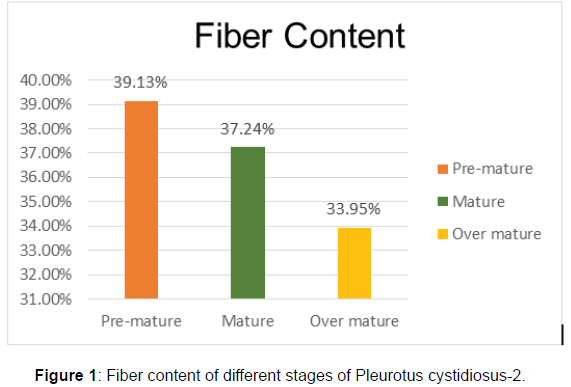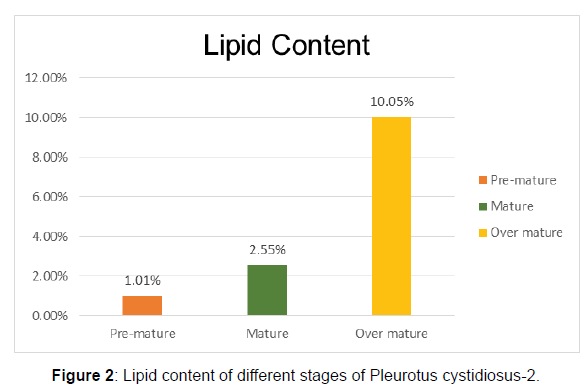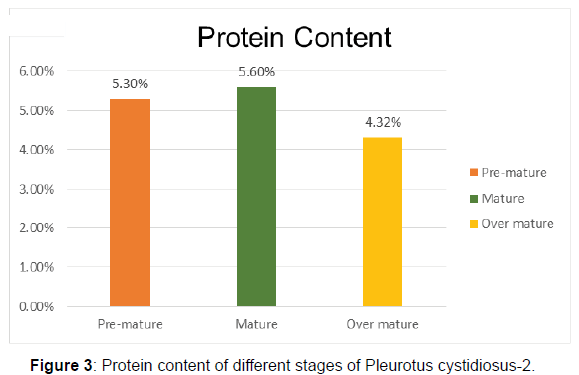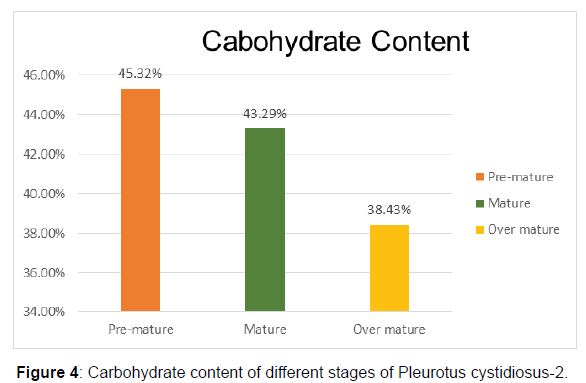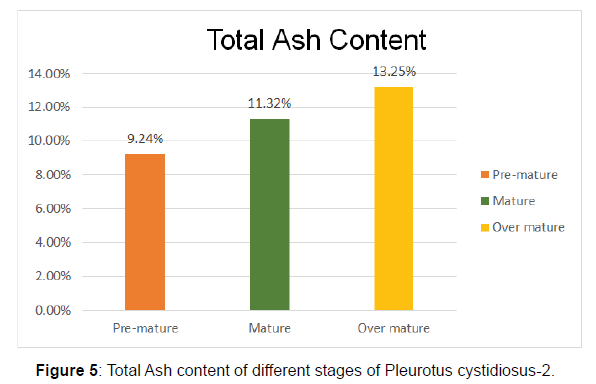Study on Maturity Level of Pleurotus cystidiosus-2 Maple Oyster Mushroom Emphasized on Organoleptic Taste and Nutrient Content
Received: 21-Oct-2021 / Accepted Date: 04-Nov-2021 / Published Date: 11-Nov-2021
Abstract
Mushroom is most diverse organisms on earth and since primitive times have played a vital role in human welfare, The fresh mushroom contains about 85-90% moisture, 3% protein, 4% carbohydrates, 0.3-0.4% fats and 1% minerals and vitamins as well as some medicinal properties like lowering blood cholesterol level, defense against cancer and invigorating hair growth, Mushroom is an organic vegetable and the production of mushroom is an ecofriendly and profitable agribusiness but labour intensive, It does not require any cultivable land and can be grown in room by racking vertically. Mushroom cultivation can help reduce vulnerability to poverty and strengthens livelihoods through the generation of a fast yielding and nutritious source of food and a reliable source of income, Mushrooms are being grown on commercial scale in many parts of the world, China produces 64 % of all edible mushrooms in the world and 85% of all oyster mushrooms all over the world (Pleurotus spp.) is also produced in China , These mushrooms have the ability to colonize and degrade a wide variety of lingo cellulosic wastes with relatively short cycle, Many studies have been conducted to test the ability of Pleurotus to grow on different agro wastes, such as cassava peels, cotton seed hulls, coffee husks, wheat straw, barely straw, saw dust and sinar straw tomato tuff fruit pulp and peel, coffee pulp, sugarcane residues . These by-products are left to rot in the field or are disposed of through burning. These residues associated with mycelium also have a great potential for use as fodder animal and as fertilizer in agriculture.
Keywords
Mushroom; Hypogenous; Environmental; Organoleptic; Nutrient content
Introduction
Mushroom is one of the most diverse organisms on earth and since primitive times have played a vital role in human welfare [1]. A mushroom is the fleshy and spore-bearing fruiting body of a fungus and belongs to the class Basidiomycetes under the order Agaricales in fungal classification, typically produced above the ground on soil or on its food substrate. It has been universally used as a food and medicine by different civilizations since ancient time due to its delicious taste, flavor, dietetic qualities and several medicinal properties [2, 3]. The fresh mushroom contains about 85-90% moisture, 3% protein, 4% carbohydrates, 0.3-0.4% fats and 1% minerals and vitamins as well as some medicinal properties like lowering blood cholesterol level, defense against cancer and invigorating hair growth [4]. Edible mushrooms are also rich in vitamins such as niacin, riboflavin, vitamin D, C, and B complex [5]. FAO recommended edible mushrooms as a food to meet protein requirement of developing countries where a large number of populations depends mainly on cereal crops [6]. Mushroom is an organic vegetable and the production of mushroom is an eco-friendly and profitable agribusiness but labour intensive [7]. It does not require any cultivable land and can be grown in room by racking vertically. Mushroom cultivation can help reduce vulnerability to poverty and strengthens livelihoods through the generation of a fast yielding and nutritious source of food and a reliable source of income [8]. Mushrooms are being grown on commercial scale in many parts of the world. The commercial cultivation first started in Europe with the beginning of last century but the history of mushroom production is very recent in Bangladesh. Wildly, 20 species of mushroom are grown in the country, of which 5-6 are poisonous; and the recommended species for cultivation are oyster (Pleurotus spp.) and white button.
Human relationships with mushrooms are ancient and fascinating. Mushrooms are macro fungi with distinctive basi diomata or ascomata which can be either hypogenous or epigenous, large enough to be seen with naked eye. The number of different kind of mushroom in the world is estimated to be around 140,000. Pleurotus sp, commonly known as oyster mushrooms, are edible fungi cultivated worldwide especially in South East Asia, India, Europe and Africa [8]. China produces 64% of all edible mushrooms in the world and 85% of all oyster mushrooms all over the world (Pleurotus spp.) is also produced in China [9]. Oyster mushrooms is the third largest [10] commercially produced mushroom in the world; however, Sánchez [11] reported that P. ostreatus is the second largest next to Agaricus bisporus in the world market. It consists of a number of different species including Pleurotus ostreatus, P. sajor-caju, P.cystidiosus, P. cornucopiae, P. pulmonarius, P. tuberregium, P. sapidus, P. citrinopileatus and P. flabellatus, which have been cultivated in temperate and subtropical regions of the world. Oysters are naturally found on rotten wood material. The growing and consumption interest of oyster mushroom is increasing largely due to its taste, medicinal and nutritional properties [12]. P. ostreatus demands few environmental controls, and their fruiting bodies are not often attacked by diseases and pests, and they can be cultivated in a simple and cheap way. All this makes P. ostreatus cultivation an excellent alternative for production of mushrooms when compared to other mushrooms. Therefore, it is better for unskilled farmers than other mushrooms. Mushroom cultivation provides an alternative employment and it contributes to food security to rural disadvantaged groups [13]. These mushrooms have the ability to colonize and degrade a wide variety of lingo cellulosic wastes with relatively short cycle [14]. Agro-industrial waste is produced in huge amounts, and it becomes an interesting substrate, due its commercial exploitation as well as associated environmental problems. Many studies have been conducted to test the ability of Pleurotus to grow on different agro wastes, such as cassava peels, cotton seed hulls, coffee husks, wheat straw, barely straw, saw dust and sinar straw tomato tuff fruit pulp and peel, coffee pulp, sugarcane residues . These by-products are left to rot in the field or are disposed of through burning. These residues associated with mycelium also have a great potential for use as fodder animal and as fertilizer in agriculture [15-21]. The objective of this study was to study on the maturity level of Pleurotus cystidiosus-2 maple oyster mushroom emphasized on organoleptic taste and nutrient content
Materials and methods
Location of experiment
Pleurotus cystidiosus-2 was collected from Mushroom Development Institute, Savar, Dhaka, Bangladesh from June to December 2019.
Extraction Procedure
Fruiting body of Pleurotus cystidiosus-2 dried first and then powered. The powered sample was then kept in 95% ethanol in different conical flask. 5% extraction of mushroom was done here (5gm mushroom in 100 ml ethanol). The conical flask of mushroom was kept in shaker for two days in 40 c. After that the solution was filtered by clothes to take solvent portion and then again the solvent portion was filtered through Whatman filter paper. After that the solvent is evaporated through rotary evaporator and the solid portion was collected. From 500gm Pleurotus cystidiosus-2 mushroom 37gm extract was collected.
Quantitative Estimation
Determination of total protein: Total protein content was measured according to the Biuret method Determination of total lipid: Total lipid was determined by slight modified method of Folch et al. (1957).
Determination of crude fiber: Crude fiber was determined by gravimetric method.
Determination of total ash: Ash was determined by following the standard Association of Official Agricultural Chemists (AOAC) method.
Determination of total carbohydrate: The content of the available carbohydrate was determined by the following equation: Carbohydrate (g/100g sample) = [100 – (Moisture + Fat + Protein + Ash + Crude Fiber)]
Results and Discussion
Organoleptic Taste or Sensory Evaluation
For sensory evaluation, we had made a board of 10 people and they had expressed their opinion. In Table 1, Score of Sensory Evaluation for Pre-mature PCYS-2 Mushroom Fries, the highest over al Appearance was good, the highest Colour was good, maximum Crispiness was less crispy, maximum Flavour was good, the highest Taste was fair and the highest Acceptability was acceptable (Table 2).
| Overall Appearance | Colour | Crispiness | Flavour | Taste | Acceptability |
|---|---|---|---|---|---|
| 4=Excellent | 4=Excellent | 5=Crispy | 4=Excellent | 4=Excellent | 4=Highly Acceptable |
| ✓ 3=Good | ✓3=Good | 4=Moderate Crispy | ✓3=Good | 3=Good | ✓3=Acceptable |
| 2=Fair | 2=Fair | ✓3=Less Crispy | 2=Slightly Odorous | ✓2=Fair | 2=Less Acceptable |
| 1=Poor | 1=Poor | 2=Leathery | 1=Bad odour | 1=Poor | 1=Not Acceptable |
| 1=Not Crispy |
Table 1: Score of Sensory Evaluation for Pre-mature PCYS-2 Mushroom Fries.
For sensory evaluation, we had made a board of 10 people and they had expressed their opinion. In Table 2, Score of Sensory Evaluation for Mature PCYS-2 Mushroom Fries, the highest Overall Appearance was Excellent, the highest Colour was good, maximum Crispiness was less crispy, maximum Flavour was good, the highest Taste was good and the highest Acceptability was acceptable. (Table 3)
| Overall Appearance | Colour | Crispiness | Flavour | Taste | Acceptability |
|---|---|---|---|---|---|
| ✓4=Excellent | 4=Excellent | 5=Crispy | 4=Excellent | 4=Excellent | 4=Highly Acceptable |
| 3=Good | ✓ 3=Good | 4=Moderate Crispy | ✓3=Good | ✓3=Good | ✓3=Acceptable |
| 2=Fair | 2=Fair | ✓3=Less Crispy | 2=Slightly Odorous | 2=Fair | 2=Less Acceptable |
| 1=Poor | 1=Poor | 2=Leathery | 1=Bad odour | 1=Poor | 1=Not Acceptable |
| 1=Not Crispy |
Table 2: Score of Sensory Evaluation for Mature PCYS-2 Mushroom Fries.
For sensory evaluation, we had made a board of 10 people and they had expressed their opinion. In Table 3, Score of Sensory Evaluation for over mature PCYS-2 Mushroom Fries, the highest overall Appearance was excellent, the highest Colour was good, maximum Crispiness was crispy, maximum Flavour was good, the highest Taste was fair and The highest Acceptability was acceptable (Table 4).
| Overall Appearance | Colour | Crispiness | Flavour | Taste | Acceptability |
|---|---|---|---|---|---|
| ✓4=Excellent | 4=Excellent | ✓5=Crispy | ✓4=Excellent | 4=Excellent | 4=Highly Acceptable |
| 3=Good | ✓ 3=Good | 4=Moderate Crispy | 3=Good | ✓3=Good | ✓3=Acceptable |
| 2=Fair | 2=Fair | 3=Less Crispy | 2=Slightly Odorous | 2=Fair | 2=Less Acceptable |
| 1=Poor | 1=Poor | 2=Leathery | 1=Bad odour | 1=Poor | 1=Not Acceptable |
Table 3: Score of Sensory Evaluation for Over Mature PCYS-2 Mushroom Fries.
| Overall Appearance | Colour | Crispiness | Flavour | Taste | Acceptability |
|---|---|---|---|---|---|
| ✓4=Excellent | 4=Excellent | 5=Crispy | 4=Excellent | 4=Excellent | ✓4=Highly Acceptable |
| 3=Good | ✓3=Good | ✓4=Moderate Crispy | ✓3=Good | ✓ 3=Good | 3=Acceptable |
| 2=Fair | 2=Fair | 3=Less Crispy | 2=Slightly Odorous | 2=Fair | 2=Less Acceptable |
| 1=Poor | 1=Poor | 2=Leathery | 1=Bad odour | 1=Poor | 1=Not Acceptable |
| 1=Not Crispy |
Table 4: Score of Sensory Evaluation for Pre-mature PCYS-2 Mushroom Soup.
For sensory evaluation, we had made a board of 10 people and they had expressed their opinion. In Table4, Score of Sensory Evaluation for Pre- mature PCYS-2 Mushroom Soup, the highest Overall Appearance was excellent, the highest Colour was good, maximum Crispiness was moderate crispy, maximum Flavour was good, the highest Taste was good and The highest Acceptability was highly acceptable (Table 5).
| Overall Appearance | Colour | Crispiness | Flavour | Taste | Acceptability |
|---|---|---|---|---|---|
| 4=Excellent | 4=Excellent | 5=Crispy | 4=Excellent | 4=Excellent | 4=Highly Acceptable |
| ✓3=Good | ✓3=Good | ✓4=Moderate Crispy | ✓3=Good | ✓ 3=Good | ✓3=Acceptable |
| 2=Fair | 2=Fair | 3=Less Crispy | 2=Slightly Odorous | 2=Fair | 2=Less Acceptable |
| 1=Poor | 1=Poor | 2=Leathery | 1=Bad odour | 1=Poor | 1=Not Acceptable |
| 1=Not Crispy |
Table 5: Score of Sensory Evaluation for Mature PCYS-2 Mushroom Soup.
For sensory evaluation, we had made a board of 10 people and they had expressed their opinion. In Table5, Score of Sensory Evaluation for Mature PCYS-2 Mushroom Soup, the highest over al Appearance was good, the highest Colour was good, maximum Crispiness was moderate crispy, maximum Flavour was good, the highest Taste was good and the highest Acceptability was acceptable (Table 6).
For sensory evaluation, we had made a board of 10 people and they had expressed their opinion. In Table 6, Score of Sensory Evaluation for Over Mature PCYS-2 Mushroom Soup, the highest over al Appearance was fair, the highest Colour was good, maximum Crispiness was less crispy, maximum Flavour was good, the highest Taste was good and the highest Acceptability was acceptable.
Nutritional analysis
| Overall Appearance | Colour | Crispiness | Flavour | Taste | Acceptability |
|---|---|---|---|---|---|
| 4=Excellent | 4=Excellent | 5=Crispy | 4=Excellent | 4=Excellent | 4=Highly Acceptable |
| 3=Good | ✓3=Good | 4=Moderate Crispy | ✓3=Good | ✓ 3=Good | ✓3=Acceptable |
| ✓ 2=Fair | 2=Fair | ✓3=Less Crispy | 2=Slightly Odorous | 2=Fair | 2=Less Acceptable |
| 1=Poor | 1=Poor | 2=Leathery | 1=Bad odour | 1=Poor | 1=Not Acceptable |
| 1=Not Crispy |
Table 6: Score of Sensory Evaluation for Over Mature PCYS-2 Mushroom Soup.
Fiber Content
The Fiber content of different stages of pleurotus cystidiosus- 2(PCYS-2) including Pre-mature, Mature and Over mature were found about 39.13gm, 37.24gm and 33.95gm respectively (Table 7 and Figure 1). In Figure 1, The Fiber content of different stages of pleurotus cystidiosus-2(PCYS-2) including Pre-mature, Mature and Over mature were found about 39.13gm, 37.24gm and 33.95gm respectively. The highest fiber content was found in the Pre-mature stage.
| Pre-mature | 39.13% |
|---|---|
| Mature | 37.24% |
| Over mature | 33.95% |
Table 7: Score of Sensory Evaluation (1).
Lipid content
The Lipid content of different stages of pleurotus cystidiosus- 2(PCYS-2) including Pre-mature, Mature and Over mature was found about 1.01gm, 2.55gm and 10.05gm respectively(Table 8 and Figure 2).
| Pre-mature | 1.01% |
|---|---|
| Mature | 2.55% |
| Over mature | 10.05% |
Table 8: Score of Sensory Evaluation (2).
In figure 2, The Lipid content of different stages of pleurotus cystidiosus-2(PCYS-2) including Pre-mature, Mature and Over mature were found about 1.01gm, 2.55gm and 10.05gm respectively. The highest lipid content was found in the Over mature stage.
Protein Content
The Protein content of different stages of pleurotus cystidiosus- 2(PCYS-2) including Pre-mature, Mature and Over mature were found about 5.30gm, 5.60gm and 4.32gm respectively (Table 9 and Figure 3).
| Pre-mature | 5.30% |
|---|---|
| Mature | 5.60% |
| Over mature | 4.32% |
Table 9: Score of Sensory Evaluation (3).
In figure 3, The Protein content of different stages of pleurotus cystidiosus-2(PCYS-2) including Pre-mature, Mature and Over mature were found about 5.30gm, 5.60gm and 4.32gm respectively. The highest protein content was found in the mature stage.
Carbohydrate Content
The Carbohydrate content of different stages of pleurotus cystidiosus-2(PCYS-2) including Pre-mature, Mature and Over mature were found about 45.32gm, 43.29gm and 38.43gm respectively (Table 10 and Figure 4).
| Pre-mature | 45.32% |
|---|---|
| Mature | 43.29% |
| Over mature | 38.43% |
Table 10: Score of Sensory Evaluation (4).
In figure 4, The Carbohydrate content of different stages of pleurotus cystidiosus-2(PCYS-2) including Pre-mature, Mature and Over mature were found about 45.32gm, 43.29gm and 38.43gm respectively. The highest carbohydrate content was found in the Premature stage.
Total Ash Content
The Total Ash content of different stages of pleurotus cystidiosus- 2(PCYS-2) including Pre-mature, Mature and Over mature was found about 9.24gm, 11.32gm and 13.25gm respectively (Table 11 and Figure 5). In figure 5, The Total Ash content of different stages of pleurotus cystidiosus-2(PCYS-2) including Pre-mature, Mature and Over mature were found about 9.24gm, 11.32gm and 13.25gm respectively.
| Pre-mature | 9.24% |
|---|---|
| Mature | 11.32% |
| Over mature | 13.25% |
Table 11: Score of Sensory Evaluation (5).
The highest total ash content was found in the Over mature stage. Two major points of this study were Sensory Evaluation or organoleptic taste of different stages of Pleurotus cystidiosus-2 and Nutritional analysis of different stages of Pleurotus cystidiosus-2. In the Sensory Evaluation or Organoleptic taste, The Overall Appearance, Colour, Crispiness, Flavour And Taste were varied in the different stages of Pleurotus cystidiosus-2 Mushrooms of Fries and Soups. In the nutritional analysis, The highest fiber content was found in the Pre-mature stage, highest lipid content was found in the Over mature stage, highest protein content was found in the Mature stage, highest carbohydrate content was found in the Pre-mature stage and highest total ash content was found in the Over mature stage. As higher protein content was in the mature stage, the mature stage are better than other two stage. As we seen through the review, Pleurotus cystidiosus is a novel edible mushroom with high nutritional and biomedical importance, since it contains a number of bioactive components develop its large number of therapeutic function. Moreover, due to high nutritional values, these mushrooms may provide significant support against malnutrition disease. Thus the majority of research programs had been focused on extract from the fruiting body and there have been fewer studies on extract from the cultivated fungi. Therefore, further research may be oriented in that direction. Since, most of the therapeutic effects of P. cystidiosus are based on in vivo and in vitro studies, clinical trials are needed to fully realize its potentials.
This study represents the Sensory Evaluation or organoleptic taste of different stages of Pleurotus cystidiosus-2 and Nutritional analysis of different stages of Pleurotus cystidiosus-2.In the organoleptic taste of pre-mature stage, the highest Overall Appearance was good, the highest Colour was good, maximum Crispiness was less crispy, maximum Flavour was good, the highest Taste was fair and The highest Acceptability was acceptable. In the mature stage, the highest Overall Appearance was Excellent, the highest Colour was good, maximum Crispiness was less crispy, maximum Flavour was good, the highest Taste was good and the highest Acceptability was acceptable. In the over mature stage, the highest Overall Appearance was excellent, the highest Colour was good, maximum Crispiness was crispy, maximum Flavour was good, the highest Taste was fair and the highest Acceptability was acceptable. In the nutritional analysis, the highest fiber content was found in the Pre-mature stage, the highest lipid content was found in the Over mature stage, the highest protein content was found in the Mature stage, the highest carbohydrate content was found in the Premature stage and
The highest total ash content was found in the Over mature stage. The survival and multiplication of mushrooms is related to a number of factors, which may act individually or have interactive effects among them. The combination of the best air temperature, moisture, nutrient conditions as well as other variables, provides a synergistic effect optimizing the production of mushrooms, with a consequent loss and cost reduction. This review points out that in order to comprehend the challenges in handling Pleurotus genus mushroom requires a fundamental understanding of their physical, chemical, biological and enzymatic properties. As we seen through the review, Pleurotus cystidiosus is a novel edible mushroom with high nutritional and biomedical importance, since it contains a number of bioactive components develop its large number of therapeutic function. Moreover, due to high nutritional values, these mushrooms may provide significant support against malnutrition disease. Thus the majority of research programs had been focused on extract from the fruiting body and there have been fewer studies on extract from the cultivated fungi. Therefore, further research may be oriented in that direction. Since, most of the therapeutic effects of P. cystidiosus are based on in vivo and in vitro studies, clinical trials are needed to fully realize its potentials.
Acknowledgement
Authors gratefully acknowledge the grant-in-aid provided by the Jahangirnagar University, Bangladesh.
References
- Emilio MI, MarÃa BG and Xosé AA (2019) Climatic and socioeconomic aspects of mushrooms. The case of Spain. Sustainability 11:1030
- Kakon AJ, Choudhury MBK (2015) Nutritional and medicinal perspective of Hericium mushroom. Bangladesh J Mushrooms 9:67-75.
- Ng’etich OK, Nyamangyoku OI, Rono J.J, Niyokuri AN, Izamuhaye JC (2013) Relative performance of oyster rmushroom (Pleurotus florida) onagro-industrial and agricultural substrate. Intl J Agron Plant Prod 4:109-116.
- Md. Nuruddin M, Begum A, Jahan SN, Bhattacharjya DK, Paul RK et.al (2017) Effect of different sawdust substrates on the growth, yield and proximate composition of white oyster mushroom (Pleurotus ostreatus). Biores Comm 3:397-410.
- Ahmed SA, Kadam JA,. Mane VP, Patil SS and Baig MMV (2009) Biological efficiency and nutritional contents of Pleurotus florida (Mont.) Singercultivated on different agro-wastes. Nat sci 7:44-48.
- World Bank.World Development Reports. Oxford University Press, Inc. NewYork; 2004.
- Chandha KL, Sharma SR (1995) Advances in horticulture mushroom, Malhotra Publication House, New Delhi
- Chang S (1999) World production of cultivated edible and medicinal mushrooms in 1997 with emphasis on< i> Lentinus edodes(Berk.) Sing, in China, Int. J. Med. Mushrooms pp. 291-300.
- Obodai M, Cleland-Okine J, Vowotor K (2003) Comparative study on the growth and yield of pleurotus ostreatus mushroom on Different lignocellulosic by-products. J Ind Microbiol Biotechnol 30:146-149.
- Sánchez C (2010) Cultivation of pleurotus ostreatus and other edible mushrooms. Appl Microbiol Biotechnol 85:1321-1337.
- H. K. P. S. G. Garcha. Nutritional importance of mushrooms. In: Mushroom biology and mushroom products Chinese University, B. J. C. S. E. Chang S, Ed., Hong Kong: Chinese University Press, 1993.
- Asmamaw T, Abebe T, Gebre K (2015) Optimization of oyster (Pleurotus ostreatus) mushroom cultivation using locally available substrates and materials in Debre Berhan,Ethiopia. J appl biol Biotechnol 3: 15-20.
- Justo MB, Guzmán MGA, González de MejÃa E, DÃaz CLG (1998) Chemical composition of three mushrooms strains ( Pleurotus Ostreatus) (Composição quÃmica de três cepas mexicanas de setas (Pleurotus Ostreatus). Archive Latin Nutr 48:359-363.
- Manzi P, Gambelli L, Marconi S, Vivanti V, Pizzoferrato L (1999) Nutrients in edible mushrooms: An inter-species comparative study. Food Chem 65:477-482.
- Bonatti M, Karnopp P, Soares HM, Furlan SA (2004) Evaluation of Pleurotus ostreatus and Pleurotus sajor-caju nutritional characteristics when cultivated in different lignocellulosic wastes. Food Chem 88:425-428.
- Shashirekha MN, Rajarathnam S, Bano Z (2005) Effects of supplementing rice straw growth substrate with cotton seed on the analytical characteristics of the mushroom Pleurotus florida (Block &Tsao). Food Chem 92: 255-259.
- Pedra W, Marino R (2006) Axenic cultivation of Pleurotus spp. in coconut exocarp sawdust supplemented with rice bran ou wheat bran (Cultivo axênico de Pleurotus spp. em serragem da casca de coco (Cocos nucifera Linn.) suplementada com farelo de arroz e/ou.  Arch Biol Sci 73: 219-225.
- Pedra W, Carnelossi M, Silva G, Yaguiu P, Lira ML, et al. (2009) Chemical and sensorial analysis of Pleurotus ostreatus cultivated in coconut exocarp supplemented with wheat bran and/or rice bran (Análise quÃmica e sensorial de Pleurotus ostreatus cultivado em casca de coco suplementada com farel. Arch Biol Sci 76: 91-98.
- Menolli J, Asai T, Capelari M, Paccola-Meirelles L (2010) Morphological and molecular identification of four brazilian commercial isolates of Pleurotus spp. and cultivation on corncob. Braz Arch Biol Technol vol. 53: 397-408.
- Omarini A, Nepote V, Grosso N, Zygadlo J, Albertó E (2010) Sensory analysis and fruiting bodies characterisation of the edible Mushrooms pleurotus ostreatus and polyporus tenuiculus obtained on leaf waste from the the essential oil production industry. Int J Food Sci Technol 45: 466-474.
- Eira A (2004) Edible fungi (Fungos comestÃveis). In: Fungi: An introduction to biology, biochemistry and biotechnology (Fungos: uma introdução à biologia, bioquÃmica e biotecnologia), ( Azevedo JL (Ed.) ed.). Caxias do Sul: Educs: Espósito E.
- Ali, MR, Hoque MS, Ahmed KU, Rahman MH (2010) Effect of Wheat Bran Supplements with Sugarcane Bagasse on the Yield and Proximate Composition of Oyster Mushroom (Pleurotus ostreatus). Bangladesh J Mushroom 4: 21-26.
- Amin SMR (2002) Performance of different Oyster mushroom (Pleurotus spp) varieties. M.S. Thesis. Bangabundhu Sheikh Mujibur Rahman Agricultural University, Salna, Gazipur. 72 .
- Amin SMR, Sarker NC, Khair A, Alam N, (2007) effects of composition, age and sterilization techniques of mother culture on the growth and yield of volvariella volvacea (bull.) singer. Bangladesh J Mushroom 1: 18-22.
- Ancona-Mendex ML, Sandoval C, Belmar-Casso R, Capetilo-Leal CM (2005) Effect of substrate and harvest on the amino acid profile of oyster mushroom (Pleurotus ostreatus). J Food Comp Analysis 18: 447-450.
- Alam N, Khan A, Hossain MS, Amin SMR, Khan LA (2007) Nutritional Analysis of dietary Mushroom Pleurotus florida Eger and Pleurotus sajorcaj (Fr.) Singer. Bangladesh J Mushroom. 1: 1-7.
- Ali MA, Hussain S, Nawaz R, Ahsan A, Siddiq M (2004) Effect of Pasteurization techniques on mycelial growth of Oyster Mushroom, Pleurotus SPP. J Agric Res 42: 201-205
- Akyuz M, Kirbag S (2010) Nutritive value of wild edible and cultured mushrooms. Turk J Biol 34: 97-102
- Alam N, Amin R, Khan A, Ara I, Shim M, et al. (2009) Comparative effects of oyster mushroom on lipid profile, liver and kidney function in hypercholesterolemic rats. Mycobiol 37: 37-42
- Alam N, Amin R, Khan A, Ara I, Shim M, et al. (2008) Nutritional analysis of cultivated mushroom in Bangladesh Pleurotus ostreatus, Pleurotus sajor-caju, Pleurotus floridai and Calocybe indica. Mycobiol 36:228-232.
- Bauerova K, Paulouicova E, Mihalava D, Svik K, Ponist S. (2009) Study of new ways of supplementary and combinatory therapy of rheumatoid arthritis with immunomodulators Glucomannan and Immunoglukan in adjuvant arthritis. Toxicol Ind Health 25: 329-335
- Beltran-Garacia MJ, Estarron-Espinosa M, Ogura T (1997) Volatile compound secreated by the oyster mushroom (Pleurotus ostreatus) and its antibacterial activities. J Agric Food Chem 45:4049-4052
- Bernas E et al. (2006) Edible mushroom as a source of valuable nutritive constituents. Acta Sci Pol Technol Aliment 5: 5-20.
- Bobek P, Galbavy S. (2001) Effect of pleuran (beta-glucan from Pleurotus ostreatus) on the antioxidant status of the organism and on dimethylhydrazine-induced precancerous lesions in rat colon. Br J Biomed Sci 58:164-168
- Brenneman JA, Guttman MC (1994) The edibility and cultivation of the oyster mushroom. Am Biol Teacher 56: 291-293
- Buswell JA and Chang ST(1993) Edible mushrooms: Attributes and applications. In: Genetics and breeding of edible mushrooms. Chang ST, Buswell JA and Miles PG (eds.) Gordon and Breach. Amsterdam 297-324.
- Chang ST, Miles PG (1989) Edible mushrooms and their cultivation: CRC press: Baco Raton. FL 1-38.
- Agrawal RP, Chopra A, Lavekar GS, Padhi MM, Srikanth N, et al. (2010) Effect of oyster mushroom on glycemia, lipid profile and quality of life in type 2 diabetic patients. Aust J Herb Med 22: 50-54.
- Ahmed M, Abdullah N, Ahmed KU, Bhuyan B (2013) Yield and nutritional composition of oyster mushroom strains newly introduced in Bangladesh. Pesq Agropec Bras 48: 197-202.
- Alam N, Khan A, Hossain MS, Amin SMR, Khan LA (2007) Nutritional analysis of dietary mushroom Pleurotus florida Eger. and Pleurotus sajor-caju (Fr.) Singer. Bangladesh J Mushroom 2: 1-7.
- Amin SMR, Sarker NC, Khair A Alam N (2007) Detection of novel supplements of paddy straw substrates on oyster mushroom cultivation. Bangladesh J Mushroom 2: 18-22.
- Association of Official Analytical Chemists (AOAC). 2005. Official Methods of Analysis of AOAC International. 16th ed.Gaithersberg, MD, USA: AOAC International.
- Banik KS, Nandi R (2004) Effect of supplementation of rice straw with bagasse residual slurry manure on the yield, protein and mineral contents of oyster mushroom. Ind Crop Prod 20:311-319.
- Adejoye OD, Adebayo-Tayo BC, Ogunjobi AA, Olaoye OA (2006) Effect of Carbon, Nitrogen and mineral sources on growth of Pleurotus florida, Nigeria edible mushroom. Afr J Biotechnol 5:1355-1359.
- Basyal E, Perker H, Yalinkilic MK and Temiz A (2003) Cultivation of oyster mushroom on waste paper with some added supplementary materials. Bio-resource Technology 89: 95-97.
- Celik Y, Pekker K (2009) Benefit/Cost analysis of mushroom production for diversification of income in developing countries. Bulg J Agric Sci 15: 228-237.
- Das N, Mukherjee M (2007) Cultivation of Pleurotus ostreatus on weed plants, BioResources Technology 98: 2723-2726.
- Madan M, Vasudevan P and Sharma S (1987) Cultivation of Pleurotus sajar-caju on different wastes. Biol Wastes 22: 241-250
- Fernandes A, Barros L, Martins A, Herbert P, Ferreira ICFR (2015) Nutritional characterisation of Pleurotus ostreatus (Jacq. ex Fr.) P. Kumm. produced using paper scraps as substrate. Food Chem Eng 169: 396-400.
- Jin Z, Li Y, Ren J, Qin N (2018) Yield nutritional content, and antioxidant activity of Pleurotus ostreatus on corncobs supplemented with herb residues. Mycobiol 46: 24-32.
- Alam N, Yoon KN, Lee TS, Lee UY (2011) Hypolipidemic activities of dietary Pleurotus ostreatus in hypercholesterolemic rats. Mycobiol 39: 45-51.
Citation: Rahman MA, Hossain A, Rahman MS, Bashir NMB, Mia R, et al. (2021) Study on Maturity Level of Pleurotus Cystidiosus-2 Maple Oyster Mushroom Emphasized on Organoleptic Taste and Nutrient Content. J Nutr Sci Res 6: 153.
Copyright: © 2021 Rahman MA. This is an open-access article distributed under the terms of the Creative Commons Attribution License, which permits unrestricted use, distribution, and reproduction in any medium, provided the original author and source are credited.
Select your language of interest to view the total content in your interested language
Share This Article
Open Access Journals
Article Usage
- Total views: 5221
- [From(publication date): 0-2021 - Dec 08, 2025]
- Breakdown by view type
- HTML page views: 4381
- PDF downloads: 840

